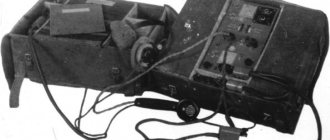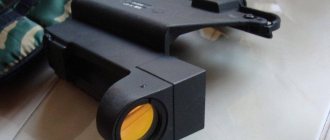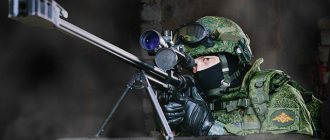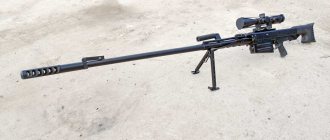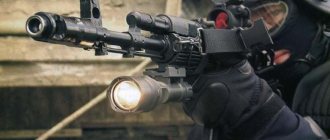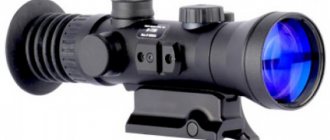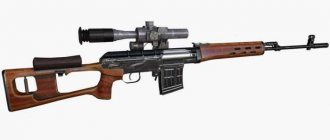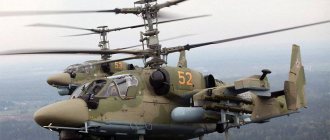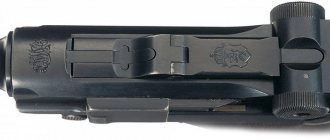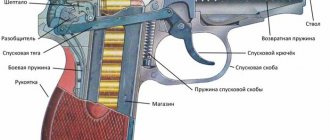AK-9 assault rifle - video
In the second half of the 1980s, designers of the Central Research Institute TochMash developed two versions of a single system of “silent” weapons, unified in parts and components and intended for silent and flameless firing at a range of up to 400 meters. The system of “silent” special-purpose weapons was represented by the special sniper rifle VSS “Vintorez” and the special assault rifle AS “Val”, which in 1987 were adopted by various special forces units of the USSR.
During their operation, some shortcomings were revealed: - short service life (5000 shots); — large-sized muffler; — impossibility of shooting without a silencer; — the presence in the design of the muffler of a spring, which is separated during disassembly and therefore often lost; — the need for cleaning after minor shooting; - high (compared to Kalashnikov assault rifles) cost.
Kalashnikov AK-9 assault rifle with PSO-1 optical sight
Taking this into account, at the beginning of the first decade of the 21st century, OJSC Concern Izhmash proactively began work on creating a new silent, flameless, compact machine gun, designated AK-9, designed for the covert destruction of various emerging, moving, open and camouflaged, single and group targets (including those protected by level II body armor) and unarmored military equipment at ranges up to 400 m.
The AK-9 assault rifle is built on the basis of the design of the “hundredth series” of Kalashnikov assault rifles, a feature of which was the use of special 9-mm (9x39) cartridges 7N9, 7N12 (SP-5, SP-6) with subsonic bullet speed (SP-5, SP- 6).
In terms of design, the AK-9 generally follows the design of the AK-74M assault rifle, differing in the shortened gas engine and barrel components.
May have various modifications. It provides mounts for an underbarrel grenade launcher, laser sight, tactical flashlights and other devices. A quick-detachable silent and flameless firing device can be installed on the barrel of the machine gun. Shooting is possible both with and without a silencer. The weapon is fed with ammunition from detachable box magazines with a capacity of 20 rounds.
The trigger mechanism allows firing single shots and in fully automatic mode. The fuse—the firing mode translator—is similar to that in the Kalashnikov assault rifle and is located on the right side of the weapon. On the left side of the receiver there is a standard rail for installing optical collimator and night sights.
The assault rifle can be equipped with a plastic folding stock with a cleaning rod similar to the AK-74M assault rifle, or a metal frame stock similar to the AKS-74 assault rifle, an ergonomic handle, and a special forend with Picatinny rail-type guides for installing additional equipment (fire control handles, tactical flashlight, laser target designator).
AK-9 with an optical sight PSO-1M2-1, a tactical flashlight and a stock similar to the AK-74M
The weapon has improved plastic fittings. Ergonomic pistol grips and buttstock are made of impact-resistant plastic. The AK-9 assault rifle was primarily developed to arm special units of the Ministry of Internal Affairs and the Russian Army.
In 2009, the silent, flameless rifle system AK-9 was demonstrated to the general public at the ROST-2009 exhibition. At the same time, pilot serial production of this machine was announced.
Like all Kalashnikov assault rifles, the AK-9 is distinguished by its reliability and ease of use, it has a high degree of unification with the AK series assault rifles, which ensures uniformity of weapon handling techniques, and allows the manufacturer to carry out mass production with maximum use of equipment, tooling and standard technological manufacturing processes of AK assault rifles.
AK-9 with a stock similar to the AKS-74 and entirely shifted to the receiver cover
Comparative tests of the AK-9 have shown that the assault rifle is superior to the Val (AS) - Vintorez (VSS) complex in terms of shot sound level, dispersion characteristics, versatility of use and some other indicators. During trial operation, the weight of the AK-9 was increased compared to the AC, but at the same time, the ease of use of the machine gun, the high efficiency and small dimensions of the muffler, and the ability to use the machine gun without a muffler to accompany and protect cargo and people were noted.
Based on the results of trial operation, a modernized model of the assault rifle was proposed, in which the weight was reduced by 400 g (without loss of reliability), the length of the aiming line was increased by 25%, and the rear sight was moved to the receiver cover, similar to the AKS74U assault rifle.
AK-9 with a front fire control handle and a tactical flashlight mounted on Picatinny rails integrated into the forend
The basis of an accurate shot: aiming rules
Kalashnikov specialist in the field of civilian small arms Georgy Gubich talks about the rules for using a closed mechanical diopter sight
More than a year ago, the article “Mechanical sights. Types and Features”, where I tried to give food for thought about what are the fundamental differences between open and closed sights, as well as describe the differences in aiming methods. It turned out that the article, in addition to the fact that it did not convince everyone, in some cases raised even more questions than it provided answers, and sometimes even led to outbursts of rage in an attempt to deny the obvious.
I think this happened due to the fact that, in essence, some readers perceived the analytical material as the rules for aiming with a diopter sight, and even superimposing on this the established aiming technique with an open mechanical sight.
Therefore, in this article I focus specifically on the rules for using mechanical sights - open and diopter. But first, let's pay attention to the ability to achieve the shooting goal by taking the rules for using scopes out of the context of the conditions.
I would like to start with quotes from the book, which can rightfully be considered the quintessence of Soviet methods of sports bullet shooting - A.A. Yuryev, “Sports Shooting”, Moscow, FiS, 1962 (Second Edition):
“An indispensable condition for correct aiming should be such a mutual arrangement of sighting devices (regardless of the types of sights) in which an “even front sight” is maintained.
When aiming with an open sight, a “flat front sight” will be such a visible arrangement of the sighting devices in which the front sight is in the middle of the sight slot, and the top of the front sight is flush with the upper edges of the slot.”
“When aiming with a diopter sight, the “flat front sight” will be the alignment of the top of the rectangular front sight (or the center of the hole in the ring front sight) with the center of the diopter hole.”
Thus, a “flat front sight” for an open sight is the top of the front sight at the same level as the top edge of the rear sight, the side gaps (if any) are the same size, and a “flat front sight” for a diopter sight is the top of the front sight in the center of the diopter hole.
For open sight:
1. Front sight in the middle of the slot
2. The top of the front sight is at the level of the rear sight mane
. The drawings presented in this article are schematic and are not capable of conveying the full picture, but will help you visualize the main points of the article.
For a diopter sight:
1. The top of the front sight is in the center of the rear sight hole
Separately, it is worth emphasizing that in the case of a diopter sight, we are talking about the top of the front sight, and not its other part (middle, 2/3, etc.). Perhaps you yourself have encountered similar manifestations in your practice:
From the point of view of directly constructing the correct aiming line, you can aim not with the top of the front sight, but, for example, with its base or protection and, subject to the condition of uniformity, such options will also work. But there’s no need to talk about ease of use. We must not forget about the different types of front sights, types of protection and the position of the front sights relative to the protection (since the vertical displacement of the STP when bringing the weapon to normal combat is often carried out by screwing in or unscrewing the front sight), and getting used to centering, for example, a round front sight relative to the diopter hole , you may encounter a problem if you pick up a weapon that does not have a warning device.
Regardless of the conditions, the position of the top of the front sight in the center of the diopter is optimal.
Let's return again to quotes from the book by A.A. Yuryev “Sports Shooting” (Second edition, Moscow, FiS, 1962):
“Thus, the accuracy of aiming depends on the shooter’s ability to always consistently maintain the “straight front sight” and align its top with the lower edge of the “apple” of the target (with the aiming point).
At first glance, the aiming scheme outlined above seems simple and understandable. But when the shooter wants to implement it in practice, he will encounter many difficulties during shooting.
The main practical difficulties that a shooter faces while aiming are due to the structural features of the eye and its operation as an optical apparatus during the aiming process.”
“... the eye cannot simultaneously clearly see objects located at different distances from it, in this case - the sight slot, the front sight and the “eye” of the target. This means that if you clearly see the front sight, then the target and the sight slot will be perceived as blurry by the eye; If you focus your vision on the target, the front sight and the sight slot will be blurry. Some shooters, while aiming when shooting a rifle, “switch” their gaze from the front sight to the slot, then to the third object - the target, doing this quickly and several times until they combine all three points on one straight line. This method of aiming causes rapid fatigue of the muscular system of the eye and can be used in the initial form of aiming training, and then only at first. With this method of aiming, it is very difficult for the shooter to conduct, for example, high-speed shooting, when he is limited by time. The same applies to standing shooting, when the athlete does not have the opportunity to pay much attention to aligning and clarifying the position of the front sight in the slot. Therefore, when aiming when shooting a rifle, the shooter must sacrifice something and strive to clearly, sharply see only one of three objects: either the front sight, or the slot, or the target.
Based on practice, the vast majority of shooters, when shooting from a rifle, try to see the front sight clearly, having to somewhat neglect the sharpness of the image and the slot of the sight and the “apple” of the target. At the same time, one should not be embarrassed by the fact that the sight slot is perceived as fuzzy and as if double..."
At first glance, everything is quite simple, obvious and known for a long time. Almost the same thing can be seen in the manual on shooting (NSD), for example:
"119. To aim, you need to close your left eye, and look through the slot of the sight at the front sight with your right eye so that the front sight is in the middle of the slot, and its top is level with the upper edges of the mane of the sighting bar, i.e. take an even front sight.”
© Manual for the 5.45 mm Kalashnikov assault rifle (AK74, AKS74, AK74N, AKS74N) and 5.45 mm Kalashnikov light machine gun (RPK74, RPKS74, RPK74N, RPKS74N). Moscow: Military Publishing House of the USSR Ministry of Defense, 1976.
We align the front sight vertically and horizontally - and “there will be happiness.”
It is worth noting that the NSD does not say anything about what exactly needs to be focused on, therefore, the correct formation of the skill remains on the conscience of the leader at the training site.
This is what working with open sights is all about. Next about the diopter. And again we return to “Sports Shooting” by A.A. Yuryev (Second Edition, Moscow, FiS, 1962):
“The diopter sight greatly facilitates and simplifies aiming, since the shooter is freed from the need to see during shooting one of the three objects (the sight slot), which is closest to the eye, and therefore the most inconvenient for visual perception.
The role of the slot in the diopter sight is performed by a small round hole (diopter). When aiming, the shooter needs to look through it and see only two objects - the front sight and the target.
To aim with a diopter sight, the shooter, looking through the diopter hole with his right eye, places the top of the rectangular front sight under the lower edge of the bull's eye or places the bull's eye in the center of the front sight ring.
When aiming, the shooter should not particularly distract his attention to searching for the center of the diopter hole and aligning the top of the front sight with it; Thanks to the sense of symmetry of the eyes, he is able to perform this work automatically and involuntarily.
If the shooter makes an inaccuracy in determining the center of the hole and the location of the top of the front sight in it and the line of sight turns out to be slightly shifted to the side, there will not be a big error in aiming, because the diopter hole itself is relatively small.
Thus, in order to ensure accurate and uniform aiming with a diopter sight, the shooter must mainly mobilize all attention to correctly and uniformly position the top of the front sight relative to the aiming point, while carefully maintaining the same clearance.
Likewise, there are no secrets.
If we turn to foreign sources, for example, the analogue of our NSD - Field manual, we will find that they talk about the same principles of an “even front sight”.
Figure 4-15. Correct sight alignment
RIFLE MARKSMANSHIP M16A1, M16A2/3, M16A4, AND M4 CARBINE (Change 4).
Washington: US Army, 2006. RIFLE MARKSMANSHIP M16-/M4-SERIES WEAPONS (Change 1).
Washington, DC: HEADQUARTERS DEPARTMENT OF THE ARMY, 2011. In the specified Field Manual FM3.22-9, although without much detail, it is mentioned that the eye can independently center the front sight in the ring of the rear sight hole.
But in reality, many people have doubts, bordering on mistrust, regarding the possibility of automatically centering the front sight in the diopter ring. The fact is that here we are hampered by stereotypes formed by the experience of working with “open mechanics”. If this is your first time shooting using a diopter sight, then you instinctively want to center the geometric center of the visible part of the front sight. We have already seen that this is incorrect, although, as discussed in the first article, a small shift will not lead to catastrophic consequences.
It must be remembered that the top of the front sight is located in the center of the rear sight hole, and not its geometric center. With the development of skill, this error disappears quite quickly, and the eye positions the top of the front sight in the center of the rear sight ring. Let's look at this through the prism of real conditions of use of weapons.
If you need to make an accurate shot, for example, at a distant small target, you can always take a split second to control the position of the top of the front sight in the diopter hole while you prepare a high-quality preparation for an accurate shot. And if you need to make a quick shot, the focus of your vision will be on the target, which you will automatically place in the center of the diopter, and small possible deviations of the front sight (which, by the way, is more clearly visible due to the effect of increasing the depth of field) from the center of the rear sight ring will not give a significant absolute deviation of the bullet from the aiming point, because if you need to fire a quick shot, then most likely the target is close and large.
Let me draw your attention to one more nuance from our NSD, namely the part where it says “you need to close your left eye”! As is often the case in instructions, there is no description or explanation of why it is necessary to squint your eyes, since such documents are made on a “read-and-follow” principle and are aimed at (or contribute to) simplifying the procedures for further copying on students. It can be assumed that in this way there is an attempt to increase control over the sighting picture and the “straight front sight” by cutting off half of the visual field or, which may be even more important, an attempt to forcibly get rid of the problem of determining the “leading” eye.
And again we return to quotes from “Sports Shooting” by A.A. Yuryev (Second Edition, Moscow, FiS, 1962):
“...the tension associated with closing the left eye is painful for many, especially for novice shooters. Another disadvantage is that closing one eye is almost always accompanied by greater or lesser tension in the muscles of the eyelids and pressure of the eyelid of the aiming eye on the eyeball; the latter affects the light refractive apparatus and thereby negatively affects visual acuity. The third point that negatively affects shooting accuracy is the involuntary dilation of the pupil of an open eye in response to covering or squinting the other eye. Based on this, it is best to turn off the second eye from work not physically - by closing your eyes, but by psychologically suppressing the visual impressions of the open, not aiming, left eye.
It follows from the text that closing your eyes has many negative aspects.
To consciously suppress the perception of the image by the “slave” eye, you can use the following training method: at the initial stage of mastering the aiming technique, the shooter closes his left eye, then learns to aim with both eyes, first slightly squinting the left eye to make an accurate shot, then gradually opening the eye more and more , proceeds to shoot with both eyes open. If there is a shortage of time for full training, it is possible to use a simple algorithm in training the shooter: close your eye - level the front sight.
The described training methodology allows you to achieve high quality aiming in classical bullet shooting and, for example, in applied military exercises AK-3 and AK-4, and if you have a high level of other skills necessary to fire a shot, a high level of shooting accuracy.
Now let’s move a little away from the mentioned conditions when:
- the goal is static;
- the goal is contrasting;
- the target is well illuminated.
And let’s consider, for example, the conditions for performing exercises according to the rules of the International Confederation of Practical Carbine Shooting in the open air.
A beige cardboard target against the backdrop of a sand bank or a white target against the backdrop of a snow-covered shooting range will be low-contrast and may be poorly illuminated, for example, by side or contrasting light. In such conditions, keeping the “straight front sight” and aligning its top with a poorly visible target will become a non-trivial task. And in the case of using “focus on the front sight” it will lead to the need for constant refocusing of the eye (accommodation) from the front sight to the target and back to clarify the correctness of aiming.
Or another situation: the bullet shooter knows for sure that there is no point in looking at the target after firing - you still can’t see the black holes in the black “apple” of the target at 50/100/300 meters. A practical shooter, when shooting at cardboard targets, also knows that there is no need to look there. But, after shooting at a metal falling target - a “popper”, even if the shooter is mentally able to make a good “mark” of the shot and there is a ringing sound of the bullet hitting, it is necessary to look at the target and make sure that the target has fallen. Otherwise, it will be considered unaffected. And here a diopter sight is more convenient than an open one - refocusing, if it is needed at all, is much easier and faster.
In the listed cases, the use of diopter sights can significantly simplify these tasks: there is no need to align the front sight in the rear sight, as already mentioned in the quote from “Sports Shooting” - the eye performs this function involuntarily; increasing the depth of field makes aiming easier; there is no need for additional accommodation of the eye. In a diopter sight, when focusing on the front sight, the “blur” of the target is much less than when looking through an open sight.
If we are guided by the content of the manuals on shooting (NSM), then to successfully complete tasks in battle, at a minimum, it is necessary:
- continuously monitor the battlefield, timely detect, evaluate and select the most important targets for destruction;
- skillfully fire at all kinds of targets in various combat conditions, both day and night, achieving the destruction of the target in the shortest possible time;
- observe the results of the fire and skillfully adjust it.
“Continuously observe the battlefield”
If you close one eye while shooting, then at least 30% of the field of view is cut off. Is it right to close your eyes in this case? The question is rhetorical.
“Skillfully fire at all kinds of targets”
A properly trained shooter should be able to do this regardless of the type of sight on his weapon. Do not forget also about the ability to determine distances to the target, as well as moving the aiming point in accordance with the excess of the trajectory, if necessary.
“Observe the results of the fire and skillfully adjust it”
It is worth noting here that the manuals list specific methods of observation and assessment: bursts of hits, bullet tracks and changes in the enemy’s behavior. Let’s return to the information about correct aiming: “flat front sight”, the top of a clearly visible front sight on a blurred target spot. If the tracks of tracer bullets are more or less visible at the same time, then observing the bursts will require shifting your gaze to the target and the space surrounding it. How long will it take to transfer focus from the front sight to the target, for example, at 200 meters, and back? About a second and a half? Plus or minus.
So it turns out - either the correct aiming picture, or a timely and, with a greater degree of probability, an effective shot.
Next, let's imagine an even more realistic situation. An enemy in camouflage camouflages himself in the bushes and moves around at the same time. How can one even fire at such a target, focusing on the front sight, while observing the results of the shooting and adjusting it if necessary, if the target is already barely visible and changes its position?
The answer is simple - when using an open sight, aiming in accordance with the canonical rules from the textbook is often impossible. They shoot, sacrificing accuracy - focusing on the target with the front and rear sights blurred. And with the advantages of a diopter sight, expressed in an increase in depth of field and the absence of the need for perfect focusing on the front sight, aimed fire at a complex target that merges with the background is real: traces are visible (when using tracer bullets), splashes of hits are visible and the enemy’s behavior is visible - remains on place, took cover or fell struck.
We should also not forget that when looking through an open sight, the shooter, maintaining a “flat front sight”, does not see the space below the level of its top. When viewed through a diopter sight, there is an observable field below the top of the front sight.
Why does dissatisfaction and denial arise among those who, having extensive experience in shooting with an open mechanical sight, tried to shoot with a diopter sight?
As a rule, everything lies in improper use. Shooters complain about the narrow field of view in the sight, about the rear sight itself, which blocks part of the view, and about the fact that it is “impossible” to center the front sight in the diopter ring.
But if you follow simple rules, which, unfortunately, are little known, then everything becomes much simpler and clearer.
Firstly,
place the eye at a distance of 4-8 cm. With this distance of the eye from the diopter hole, a balance is maintained between the angle of the field of view through the diopter hole and the ease of intuitive placement of the top of the front sight in the center of the hole. In this case, the rear sight ring blurs into a ghostly shadow and becomes almost invisible. A shooter who does not close his eyes when shooting cannot lose part of his field of vision at all because the entire missing picture from the right pupil will be supplemented by the brain with information from the left. The required distance from the diopter to the eye can be maintained either by adjusting the position or by changing the length of the adjustable butt. By the way, it is not possible to install a diopter sight on every type of small arms, precisely because of the requirements for distance to the eye.
Secondly,
If you have just begun to master shooting using a diopter sighting device, you need to concentrate your attention on the location of the upper section of the front sight in the center of the diopter. In the future, there is practically no need to make any significant efforts to center the top of the front sight in the rear sight ring, as has already been said not only by me, but also given in the quotation from, I am not afraid of this word, the greatest work on teaching the technique of making a well-aimed shot. will do this involuntarily. The same thing was mentioned in the first article, when the ability of a diopter sight to reduce parallax was briefly described. You can read more about this effect in a recently published translation of a practical study on this topic.
Third,
the canonical rule is “focus on the front sight.” But, depending on the conditions, thanks to an increase in the depth of field of the imaged space, in order to achieve the goals of firing a shot, it is possible to shift the focus of vision to the target without losing the quality of aiming.
And again, briefly about the rules of shooting using a diopter sight (after determining the distance to the target, installing the sight and/or moving the aiming point and forming the correct position, which will ensure the necessary distance of the eye from the sight):
- focus on the front sight;
- the top of the front sight is in the center of the diopter;
- the top of the front sight at the aiming point.
SUMMARY
ANY mechanical sighting device allows you to make an accurate shot, provided that the shooter is able to distinguish the target, the only question is skill. But there is no denying that different types of scopes have their own unique advantages and disadvantages.
The predominance of the advantages of one type of sight over another in specific conditions of use determines our choice of sighting device. And it is precisely for the correct understanding and high-quality use of sighting devices that the appropriate competencies are needed. If you don’t know how to use a microscope, then it turns out that a magnifying glass works better.
Photo of AK-9
AK-9 (handguard view)
AK-9 (view of controls)
Similar
AK-47 assault rifle cartridge caliber 7.62 mm. Device. Rate of fire
AK-74 assault rifle cartridge caliber 5.45 mm. Device. Rate of fire
Dragunov SVD sniper rifle caliber 7.62 mm. Device
AKS-74U assault rifle cartridge caliber 5.45 mm. Device. Weight
Mauser K96 pistol cartridge caliber 7.63 and 9 mm. Device
Pistol Walter PP / PPK cartridge caliber 7.65 and 9 mm. Device
Pistol Yarygin PYa Grach cartridge caliber 9 mm. Device
DShK machine gun cartridge caliber 12.7 mm. Device. Rate of fire
Luger pistol R.08 Parabellum cartridge caliber 9 mm. Device
Pistol PM cartridge caliber 9 mm. Rate of fire. Dimensions. Bullet speed. Sighting range
Self-loading shotgun Saiga-12 cartridge, caliber. Device
Maxim machine gun cartridge caliber 7.62 mm. Device. Weight
PPSh-41 Shpagina submachine gun cartridge caliber 7.62 mm
APS Stechkin pistol cartridge caliber 9 mm. Device
Nagan system revolver cartridge caliber 7.62 mm. Device
Kalashnikov PK machine gun and PKM cartridge caliber 7.62 mm. Device
Simonov carbine SKS-45 cartridge caliber 7.62 mm. Device
Rifles and carbines Mauser 98 caliber 7.92 mm. Device
PPS-42 and PPS-43 Sudaev submachine gun cartridge caliber 7.62 mm
Pistol Walter P38 cartridge caliber 9 mm. Device
MP-40 German submachine gun cartridge caliber 9 mm. Device
VSS Vintorez sniper rifle caliber 9 mm. Device
Submachine gun PP-91 Kedr cartridge 9 mm caliber. Device
Light machine gun RPK-74 cartridge caliber 5.45 mm. Device
Pistol Glock 17 cartridge caliber 9 mm. Device
Makarych, Izh-79-9T, MR-79-9TM, MP-80-13T traumatic pistol
AK-12 assault rifle cartridge caliber 5.45 mm. Device. Weight
Mosin rifles and carbines Three-line caliber 7.62 mm
PMM Makarov pistol modernized 12 rounds. Device
Revolver Colt Single Action Army (SAA) Peacemaker. Device
Machine gun PKP Pecheneg cartridge caliber 7.62 mm. Device
Sniper rifle VSSK Exhaust caliber 12.7 mm. Device
Beretta pistol 92 cartridge caliber 9 mm. Device
TT - Tokarev pistol cartridge caliber 7.62 mm. Device
Submachine gun PP-19 Bison cartridge caliber 9 and 7.62 mm. Device
Sniper rifle SV-98 caliber 7.62 mm. Device
Vladimirov KPV machine gun cartridge caliber 14.5 mm. Device
ASH-12 assault rifle cartridge caliber 12.7 mm. Device. Rate of fire
PSM pistol cartridge caliber 5.45 mm. Device
Pistol Colt M1911A1 cartridge caliber 45. Device
Smith-Wesson revolver Russian cartridge, caliber 10.67 mm. Device
Degtyarev DP-27 light machine gun, 7.62 mm caliber cartridge. Device
Shotgun Mossberg 500 Cartridge. Dimensions. Rate of fire. Sighting range
Thompson submachine gun cartridge caliber 11.43 mm. Device
Pistol USP Heckler und Koch cartridge, caliber. Device
Hunting carbine OSK-88 (SVT-40) caliber 7.62 mm. Device
AS Val silent automatic cartridge caliber 9 mm. Device
Submachine gun PP-19-01 Vityaz cartridge 9 mm caliber. Device
Machine gun Kord cartridge caliber 12.7 mm. Device. Weight. Sighting range
Osa - traumatic pistol cartridge, caliber. Device
AK-9 assault rifle cartridge caliber 9 mm. Device. Rate of fire
Degtyarev RPD light machine gun, 7.62 mm caliber cartridge. Device
Automatic OTs-14 Groza cartridge caliber 9 mm and 7.62 mm. Device
Czech pistol CZ-75 (modifications). Device
Browning pistol 1903 cartridge caliber 9 mm. Device
Sniper rifle OSV-96 caliber 12.7 mm. Device
FN P90 submachine gun cartridge caliber 5.7 mm. Device
Submachine gun OTs-02 Cypress cartridge caliber 9 mm. Device
Sniper rifle ASVK Kord caliber 12.7 mm. Device
Automatic AEK-971 Cartridge. Caliber. Device. Rate of fire
Steyr AUG assault rifle (A1, A2, A3) cartridge caliber 5.56 mm
AK series 100 assault rifles. Modifications. Device. Weight. Dimensions
Uzi submachine gun. Cartridge. Caliber. Rate of fire
Pistol SR1M Gyurza cartridge caliber 9 mm. Device
Pistol GSh-18 cartridge caliber 9 mm. Device
SVDK sniper rifle caliber 9.3 mm. Device
Automatic SR-3M Whirlwind cartridge caliber 9 mm. Device
Machine gun NSV-12.7 Utes cartridge, cal. Device. Weight
Kalashnikov RPK light machine gun cartridge caliber 7.62 mm. Device
Sniper rifle VSK-94 caliber 9 mm. Device
Vostok-1 (Jorge-3M) 9mm caliber traumatic pistol. Device
Degtyarev PPD submachine gun cartridge caliber 7.62 mm
English sniper rifle L96A1 cartridge, caliber
M1 Garand rifle cartridge caliber 7.62 mm. Device
Desert Eagle pistol. Device
Smith-Wesson revolver (modifications). Device
Automatic rifle HK G36 (E, K, C, KE) cartridge caliber 5.56 mm
Pistol P-96 cartridge caliber 9 mm. Device. Rate of fire
Pistol GP35 Browning High Power cartridge, caliber. Device
Assault rifle FN SCAR (L, H) cartridge caliber 5.56 and 7.62 mm
Revolver Lefoshe M1856 cartridge caliber 11 mm. Device
Submachine gun PP-90 cartridge caliber 9 mm. Device
AN-94 Abakan automatic Nikonov cartridge caliber 5.45 mm. Device
Submachine gun PP-2000 cartridge caliber 9 mm. Device
Mauser pistol HSc cartridge caliber 7.65 and 9 mm. Device
M16 automatic rifle cartridge caliber 5.56 mm. Device
Fedorov assault rifle cartridge caliber 6.5 mm. Device. Rate of fire
Pistol Baltiets cartridge caliber 7.62 mm. Device
Strizh pistol cartridge caliber 9 mm. Device. Weight. Sighting range
Browning pistol 1910 cartridge caliber 7.65 and 9 mm
Silent pistol PSS Vul cartridge caliber 7.62 mm. Device
Pistol SIG-Sauer P226 cartridge caliber 9 mm. Device
Pistol OTs-27 Berdysh cartridge caliber 7.62 mm and 9 mm. Device
AK-107 assault rifle cartridge caliber 5.45 mm. Device. Rate of fire
OTs-44 sniper rifle, caliber 12.7 mm. Device
German machine gun MG3 cartridge caliber 7.62 mm. Device
Self-loading shotgun Browning Auto-5 cartridge, caliber. Device
Submachine gun AEK-919K Kashtan cartridge caliber 9 mm. Device
PB pistol silent cartridge 9 mm caliber. Device
Pistol OTs-33 Pernach cartridge caliber 9 mm. Device
Hunting carbine KO-98 cartridge caliber 7.92 mm. Device
TK (Korovin pistol) caliber 6.35 mm. Device. Weight. Dimensions
Underwater assault rifle APS cartridge caliber 5.66 mm. Device
Pistol OTs-21 Malysh cartridge caliber 9 mm. Device
American M60 machine gun, 7.62 mm caliber cartridge. Device
MTs-116M sniper rifle, caliber 7.62 mm. Device
Automatic 9A-91 cartridge caliber 9 mm. Device. Rate of fire
Submachine gun PP-93 cartridge caliber 9 mm. Device
VAG-73 - Gerasimenko pistol. Device. Weight. Dimensions
Cordon-5 is a traumatic pistol. Device. Weight. Dimensions
Goryunov SG-43 heavy machine gun cartridge caliber 7.62 mm. Device
Webley revolver cartridge, caliber. Device. Dimensions. Weight
Machine gun AEK-999 Badger cartridge caliber 7.62 mm. Device
RP-46 machine gun, 7.62 mm caliber cartridge. Device. Rate of fire
Sniper rifle VS-8 cartridge caliber 8.6 mm. Device
Slostin machine gun cartridge caliber 7.62 mm and 14.5 mm. Device
Assault rifle Tavor TAR-21 cartridge caliber 5.56 and 5.45 mm
Submachine gun SR-2 Veresk cartridge caliber 9 mm. Device
Lancaster pistol cartridge caliber 12.1 mm. Device. Rate of fire
Submachine gun PP-90M1 cartridge caliber 9 mm. Device
Underwater pistol SPP-1M. Device. Weight. Dimensions
Traumatic pistol MP-461 Guard. Device. Weight. Dimensions
Lebel rifles and carbines are cartridgeed in 8 mm caliber. Device
Automatic A-91 cartridge caliber 7.62 mm. Device. Rate of fire
M14 automatic rifle cartridge caliber 7.62 mm. Device
Revolver Smith & Wesson Model 10 Military & Police
Automatic rifle FN FAL cartridge caliber 7.62 mm. Device
Submachine gun STEN MK 2. Device. Weight. Dimensions
Traumatic pistol IZH-78-9T Chain mail cartridge caliber 9 mm
Leader-M traumatic pistol 11.43×32T. Device. Weight. Dimensions
Ingram M10 and M11 submachine gun. Device. Weight. Dimensions
Pistol Steyr M9-A1 cartridge caliber 9 mm. Device. Weight
Pistol OTs-23 Dart cartridge caliber 5.45 mm. Device
Berthier rifles and carbines caliber 8 mm. Device
Automatic shotgun USAS-12 cartridge caliber 18.5 mm
Sniper rifle VS-121 caliber 7.62 mm. Device
Traumatic pistol MP-353 cartridge, caliber 11.43 mm
Tiss machine gun cartridge caliber 9 mm. Device. Rate of fire
Traumatic pistol MP-355 cartridge caliber 9 mm. Device
Automatic double-medium ADS cartridge caliber 5.45 mm. Device. Rate of fire
Traumatic pistol MP-81 cartridge caliber 9 mm. Device
Pistols Zastava 70 and 70(k), cartridge caliber 7.65 or 9 mm. Yugoslavia
Sniper rifle GALATZ (Galil) cartridge caliber 7.62 mm
Pistol MP-444 Bagheera cartridge caliber 9 mm. Device
Revolver Colt New Army / Navy. Device. Bullet speed. Sighting range
Type 64 is a Japanese automatic rifle. Device
